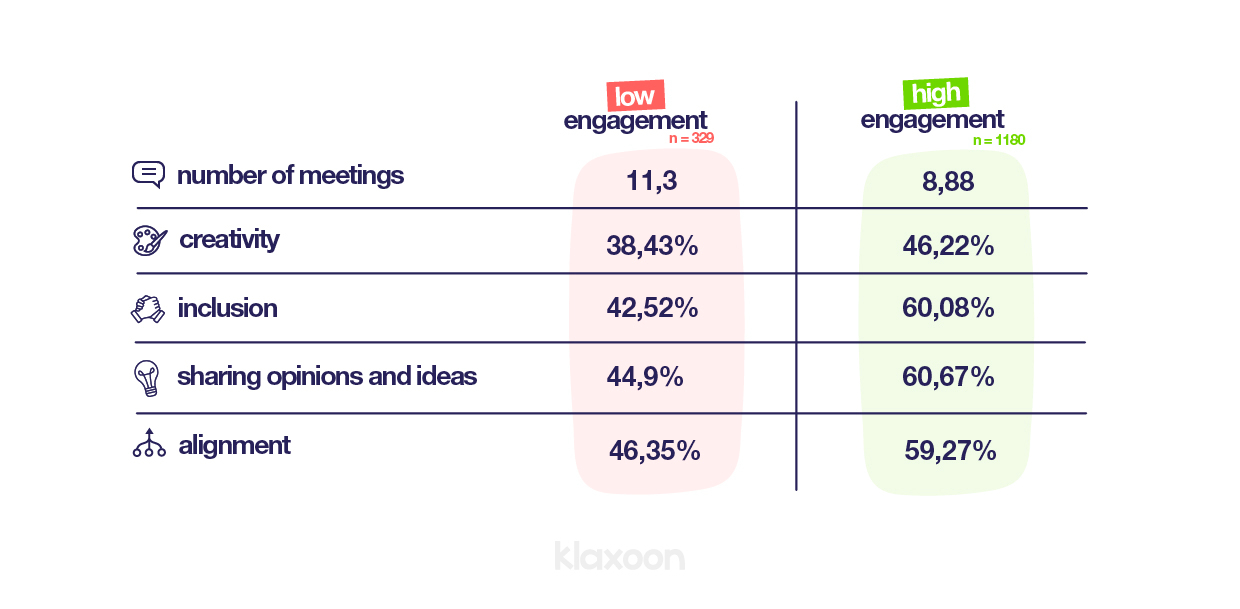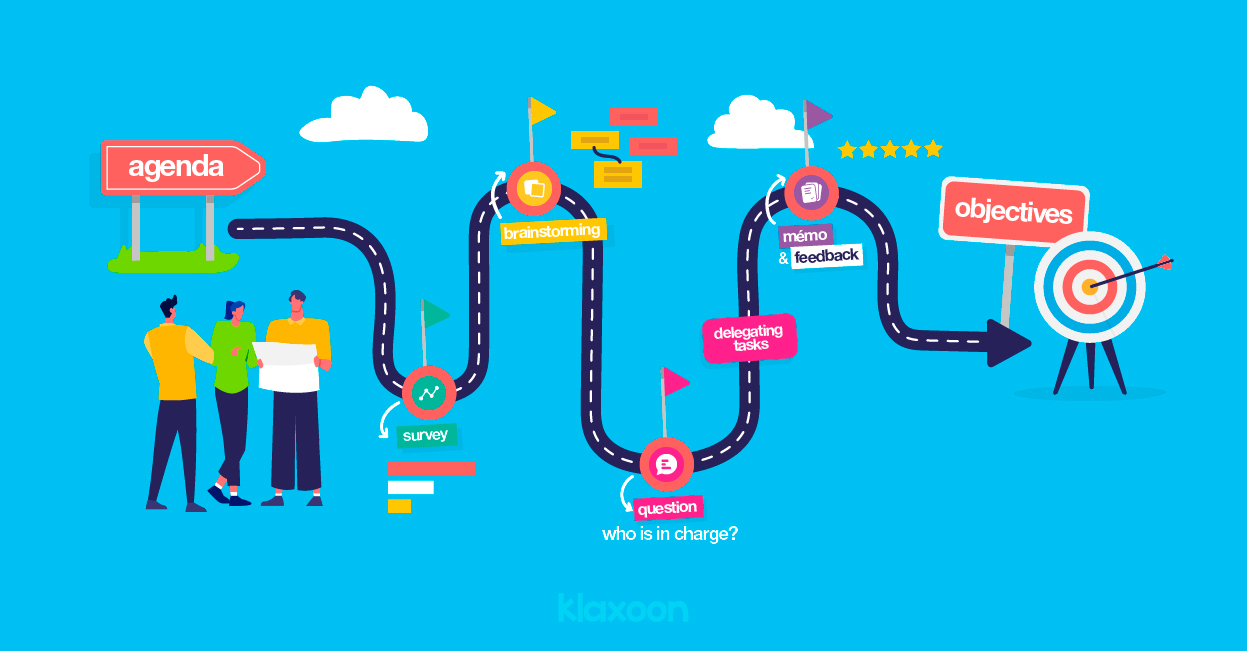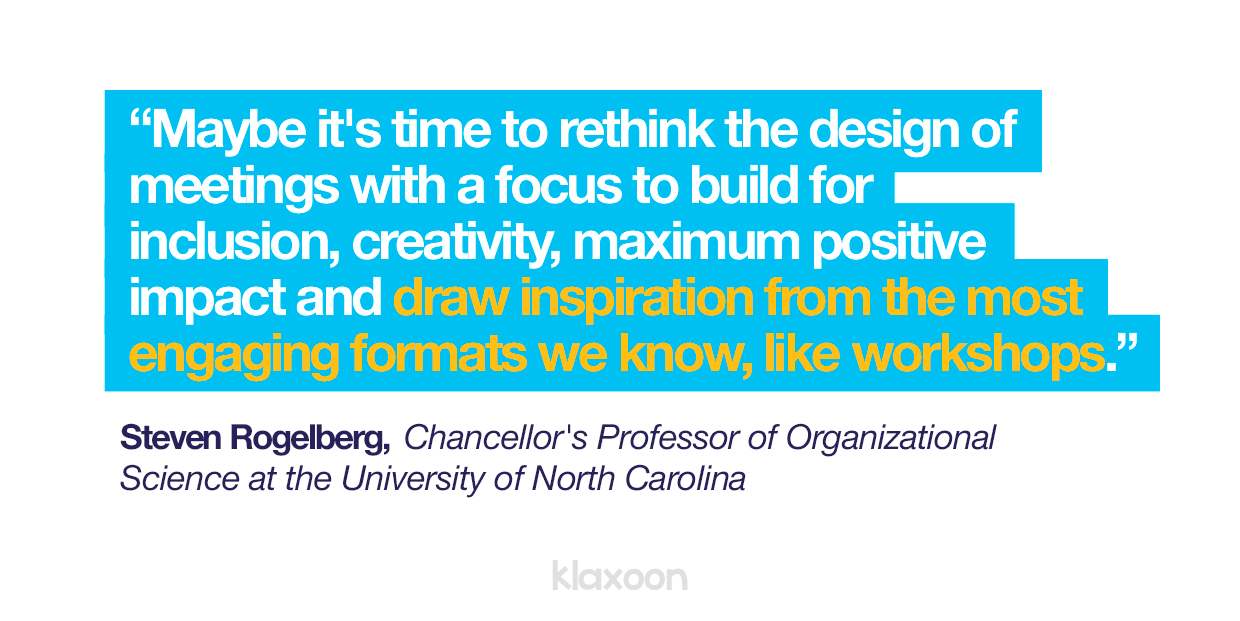Steven Rogelberg/Klaxoon Study: To Improve Employee Engagement in Meetings, Do Workshops Instead
Published on February 14, 2025
Steven Rogelberg/Klaxoon Study: To Improve Employee Engagement in Meetings, Do Workshops Instead
Collaboration patterns must change to keep talented teams engaged. This is the conclusion of Steven Rogelberg, Chancellor's Professor of Organizational Science at the University of North Carolina (USA) and author of the bestseller The Surprising Science of Meetings. With Klaxoon, he conducted a study on the subject of corporate meetings.
According to this study, the transformation of collaboration methods is irreversible, especially in the health context we have been experiencing during the past years. Inclusion, alignment and sharing of ideas must become the new pillars of collaboration. Let's deep-dive into this.
More than one in two people believe that business meetings are a hindrance to creativity. The exact figure is 56%. One of the many results of a study conducted with Klaxoon on meetings in the workplace and led by organizational science professor and author of the best-selling The Surprising Science of Meetings, Steven Rogelberg.
For this study, 2,685 people were interviewed in four countries (Germany, the United States, France and the United Kingdom). According to this specialist in collaboration, "the results of the study suggest that employees must work on improving the way they interact to become more efficient.” Among the main expectations identified by the study are:
And the first finding is clear: to be effective, employees need to go beyond the meetings as we know them.
Do you feel comfortable enough to share a dissenting opinion in a meeting? More broadly, do you still feel like you are a vital cog in the wheel of those same meetings? If you answer "of course" or "obviously," you're barely part of the majority of the study.
In fact, half of the surveyed people don't feel confident enough to express an opinion contrary to the prevailing one. A "very low" figure for Steven Rogelberg.
And the same goes for the feeling of inclusion: barely one person in two feels perfectly included in the meetings he or she attends.
Among the indicators of an effective meeting, Steven Rogelberg's study also highlights the notion of alignment. He defines it as the quality of the action plan following the meetings, i.e. how the participants take ownership of the discussions, distribute the tasks to be carried out and the means to accomplish them.
These two concepts of inclusion and alignment are highly dependent on the level of engagement of the panel. For example, among people who say they are not very involved in their meetings, the feeling of inclusion during meetings is only 42%. Conversely, among the most engaged, this feeling climbs to 60%. The table below from the study confirms this trend for all indicators.
We can therefore say that the more surveyed people feel engaged in their meetings, the greater the sense of inclusion and alignment. Does this seem obvious to you?
Yet, that is the very point of the question.
Is it a high level of employee engagement in meetings that generates better results in terms of inclusion, alignment and creativity, or the opposite? For Steven Rogelberg, the answer is clear: "Maybe we should rethink the format of meetings by focusing on the issues of inclusion and creativity. Make sure we have a positive impact and take inspiration from the most engaging collaborative formats, like workshops."


Average panel response rate based on whether people say they are low or high employee engagement in their meetings.
Workshops are the best solutions for generating effective and engaging collaboration. They are the result of good alignment, ease of expression and a high sense of inclusion. A few good practices can help develop them. Around two axes:
Preparation and structuring are key elements of your workshops. In particular, they help combat preconceived ideas about this style of teamwork.
For Steven Rogelberg, the combination of these two key factors creates a space for discussion that is conducive to speaking up and asserting oneself even in opposition to the prevailing opinion. "Respondents believe that creating a space in which they would feel more comfortable sharing their ideas is key to fostering a sense of inclusion. To that end, they also mention the idea of making these meetings more informal."
They also emphasize the attitude of individuals. It's not enough to want to create a caring space to have one. You have to set very strict rules about how to behave. "It's everybody's business. There must be 'zero tolerance' for those who would disrespect, judge or devalue others. Doing so sends a positive signal to all your future workshops.”
There are many ways to design your discussion space: creating small discussion groups or theming your workshops, to give just two examples. This creates a framework for dialogue.
In addition to a welcoming space, having a meeting agenda is not less important. There is nothing worse than a meeting without an agenda. It's like organizing a soccer game and forgetting the ball. It brings peoples’ talent together, but produces nothing effective. The study puts a lot of emphasis on this dimension. To avoid "the meeting going off the rails and everyone getting lost", says Steven Rogelberg. It also establishes the correlation between a clear agenda and the fact that teams stay focused together on the same subject.
Among the other benefits of the agenda, it helps to energize the meeting by creating dedicated moments for participation. For example, to answer a survey or to do a brainstorming session. This promotes a sense of inclusion and creativity.
Steven Rogelberg recommends providing this agenda in advance to encourage teams to prepare for the meeting and ultimately speak up. Finally, he emphasizes that respecting the agenda (and especially the timings) is necessary to keep everyone's attention.
Finally, encouraging delegation and task sharing is an excellent way to ensure alignment. "Each team member then knows exactly what they are supposed to do. In the longer term, linking these actions to the objectives to be reached and seeing that the team communicates on its progress on the projects consolidates this alignment mechanism", as says Steven Rogelberg.


From the meeting agenda to the realization of the action plan, commitment is the result of a clear and effective structure for all.
With a solid and well-designed structure, your workshops will become reassuring spaces for your teams. There, everyone will feel comfortable enough to speak up. And afterwards, this process will also allow you to better synchronize everyone's actions after the meetings, and thus to perform better.
Feeling valued, bringing an added value, being able to speak up. These are all interactions that contribute to making your workshops inclusive. For Steven Rogelberg, these interactions are central and can easily be implemented in your workshops.
And first of all, why wait for someone to give you an opinion on this or that subject? Solicit your talents, they are just waiting for it! "This is one of the most frequently mentioned strategies in the study: being invited to speak. It's an opportunity for everyone invited to present their ideas and enrich the meeting." And there is no shortage of ways to do this. Open-ended questions, voting, polls, quizzes, team relays,... There are perhaps as many possible methods as there are individuals to interview.
If you are asking your colleagues for ideas, listening to their suggestions is at least as important. Because all the surveys and brainstorming will only be useful if the ideas expressed are welcomed by the whole group. "This means creating spaces for discussion where all the ideas and opinions are valuable to the group," says Steven Rogelberg. In fact, most brainstorming models include a stage in which all ideas are welcome, precisely to avoid missing any good ones. In a design thinking approach for example, this is even central in the ideation process. And then, workshops become immediately more inclusive.
Final tip, rephrase everything! This is the last gear to conclude your workshop. Your action plan is ready, all you have to do is make sure that everyone is clear on what actions to take, for what purpose and by when. "This is the ideal moment to clarify a point. It makes it easier to understand what is at stake and puts each team member on the same level of information before launching into the implementation of the action plan."
Far from an exact science, employee engagement in their meetings remains dependent on a variety of factors that can be influenced. The results of Steven Rogelberg's study prove it. Working on more inclusive formats that encourage all stakeholders to speak up and align will always be more effective than offering long, unplanned, top-down meetings.


As the Covid-19 pandemic has led to more virtual meetings, more and more companies are choosing to work in a hybrid way. Then, moving towards more engaging organizational models like workshops is an opportunity to be seized to increase employee engagement in meetings.
Unlock your teamwork potential